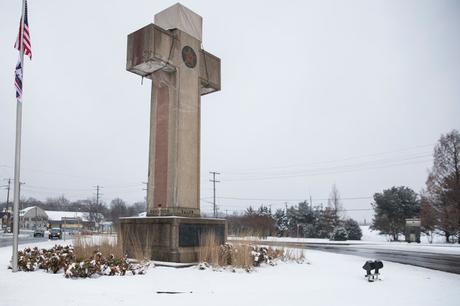 (Photo is by Sarah Silbiger in The New York Times.)
(Photo is by Sarah Silbiger in The New York Times.)The Constitution of the United States, in its First Amendment, guarantees freedom of religion. It has been taken to mean that the government (which our Founding Fathers said was secular) should not favor one religion over any other religion, or demand a citizen adhere to any religion.
But that has not been the case in the past. It is fairly commonplace in this country for religious displays (Ten Commandments, Christmas displays, etc.) to be placed on government property with the blessings of that government -- in spite of the fact that such displays clearly favors one religion (christianity) over others, giving at least the appearance that christianity is the government-favored religion.
A case was argued before the Supreme Court last week that involved this very phenomenon -- the placing of christian symbols on government property. The case involves a 40-foot cross placed on government property by the American Legion that purports to honor World War I soldiers (see picture above). It is clearly a christian symbol, even though not all those soldiers were christian.
Does that cross violate the United States Constitution? I believe it does. We'll find out this summer what the Supreme Court thinks. Sadly, I expect they will allow the cross to remain on government property -- making a hollow joke of the First Amendment's religious freedom clause.
Here is part of what the editorial board of The New York Times had to say:
This week’s hearing, in American Legion v. American Humanist Association, involved a 40-foot cross in Bladensburg, Md., that was erected 93 years ago to honor fallen World War I soldiers. The question before the court: Is Maryland in violation of the First Amendment because the memorial is on public property and maintained with public funds? Over the years, the justices have tried to come up with rules to assess all kinds of religious emblems and practices carrying the government’s imprimatur — sectarian prayers in legislative sessions, war memorials, Ten Commandments and Christmas displays, and mottos on seals or currency. Lower court judges are confused about how to apply the Supreme Court’s dictates in this area of the law, so more clarity from the high court — if not a definitive, bright-line rule — is in order. Alas, such clarity doesn’t seem to be on the horizon. After Wednesday’s hearing, the court seems poised to allow the cross — which otherwise bears no religious inscriptions — to stay. But the justices don’t appear to be any closer to consensus on this issue than they’ve ever been. “I mean, it is the foremost symbol of Christianity, isn’t it?” Justice Elena Kagan asked at Wednesday’s session. “It invokes the central theological claim of Christianity, that Jesus Christ, the son of God, died on the cross for humanity’s sins and that he rose from the dead. This is why Christians use crosses as a way to memorialize the dead.” Justice Stephen Breyer, who in the past has wrestled with the Constitution’s religion clauses, pondered whether “history counts” when assessing a monument’s legality. Maybe older displays, erected when the nation wasn’t nearly as religiously diverse, should be allowed, he suggested. “We’re a different country,” Justice Breyer said. “We are a different country now, and there are 50 more different religions.” The Trump administration, which isn’t a party in the case, has nonetheless weighed in, participating in oral arguments in support of the Maryland monument and other memorial crosses on federal property that could be similarly challenged. In the administration’s view, the Maryland cross is secular in context and not an endorsement of any particular faith, and only displays that “coerce” religious belief or adherence ought to be considered unconstitutional. Taking offense at a passive display is not enough. Arlington National Cemetery provides a good example of the kind of nondiscrimination the government should be aiming for: Federal rules allow for a wide array of religious and nonreligious symbols on headstones. “That’s the way this sort of thing is being handled today in a pluralistic society in which ordinary people … are not at each other’s throats about religious divisions,” Justice Samuel Alito said of Arlington on Wednesday. That’s fair enough. But with its recent rulings, the Supreme Court has only muddied the separation between church and state by taking seriously religious objections to contraception, civil rights laws and the allocation of public funds. It is hard to fathom the justices being nearly as accommodating with a publicly funded monument to atheism or a Wiccan pentagram. And last month, the court couldn’t even agree that a Muslim death-row prisoner from Alabama deserved the same rightsas Christians in his final moments. However the justices resolve this the dispute, they would be wise to not sow more confusion in this area of the law and feed the perception that only certain religions and practices get a fair shake in public life.

